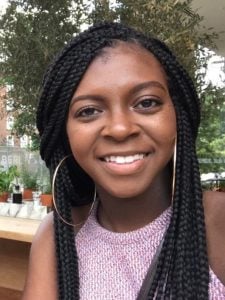
Today, when someone experiences heart disease—the No. 1 killer in the U.S.—surgeons often use stents and grafts to bypass the diseased blood vessels. While helpful, this approach is a temporary solution; not one that allows the vasculature to recover its function.
Fourth-year PhD candidate Bria Macklin is trying to develop a more permanent approach. Her research is laying the groundwork toward a long-term goal of deriving vascular cells from stem cells, growing the vessels in vitro, and then implanting or injecting them into patients to replace the diseased vasculature.
 In the shorter term, the Baltimore native is focusing on characterizing the stem-cell derived vascular cells to ensure the cells are, in fact, functional vascular cells before using them in the modeling that will eventually lead to patient-specific therapies. While the usual approach to characterization is studying the surface markers or proteins, Macklin does functional assays to look at the interactions between different vascular cell types in 3D, at how they respond to low-oxygen environments, and at whether they have therapeutic capability by using a diabetic retinopathy mouse model.
In the shorter term, the Baltimore native is focusing on characterizing the stem-cell derived vascular cells to ensure the cells are, in fact, functional vascular cells before using them in the modeling that will eventually lead to patient-specific therapies. While the usual approach to characterization is studying the surface markers or proteins, Macklin does functional assays to look at the interactions between different vascular cell types in 3D, at how they respond to low-oxygen environments, and at whether they have therapeutic capability by using a diabetic retinopathy mouse model.
“We’re making sure these cells are actually functional,” Macklin says. “The body is a highly dynamic environment; we want to simulate this in vitro before implanting them.”
Earlier this year, Macklin’s research skills were recognized with an F31 fellowship from the National Institutes of Health. The fellowship is designed to support doctoral students with supervised research training, and will allow Macklin some financial freedom in the directions she takes her research.
“Some of what we do is part engineering, part bio,” Macklin says. “With the more advanced bio techniques that can be pricey, like sequencing, this will give us more wiggle room.”
Looking ahead, Macklin hopes to broaden her research with stem-cell derived cells; as they can be used to build whole organs, she envisions improving the cells to meet those needs. “I want to see how we can improve the differentiation and characterization of stem-cell derived cells in order to have the engineered therapies using those cells work better,” she says.
She expects to bring with her the interdisciplinary approach she uses at Johns Hopkins, borrowing expertise from colleagues in far-flung departments and collaborating across fields. “It’s really nice to have the ability to know you can reach out and ask for help, and not have to teach yourself an entire discipline,” she says.